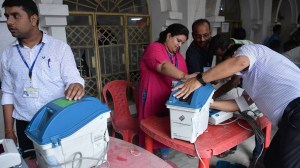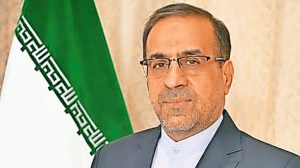- India
- International
Shaktikanta Das: ‘If opinions differ… better I address govt directly, internally… focus only on outcome’
RBI Governor Shaktikanta Das underlined the central bank’s focus on growth and financial stability, its relationship with the government and the challenge in sustaining the first trickle of positive numbers.
 RBI Governor Shaktikanta Das at his office in New Delhi on Monday. (Express Photo by Tashi Tobgyal)
RBI Governor Shaktikanta Das at his office in New Delhi on Monday. (Express Photo by Tashi Tobgyal)
Shaktikanta Das took over the reins at Reserve Bank of India as its 25th Governor on December 12, 2018. It came at a critical time when relations between the government and RBI had hit a rough patch. In an interview February 17 with Anil Sasi and P Vaidyanathan Iyer, Das underlined the central bank’s focus on growth and financial stability, its relationship with the government and the challenge in sustaining the first trickle of positive numbers
It’s been more than a year now for you as RBI Governor, coming after exits of two governors and one deputy governor. How has the year been in terms of RBI-government relationship?
For the central bank, it’s never a dull moment, especially in today’s world, and I’m saying so not just in the context of RBI, but for all central banks. Economies across the world are changing so fast, with new technologies, new business models, new challenges. So, the central bank will always have to be in sync with the changing situations. With regard to the other part of your question, the RBI is a very strong organisation; it has people who are very well experienced and thorough. There is lot of domain knowledge available within the RBI. So, regardless of the leadership, the institutional stability is always maintained. Therefore, it has been a smooth transition. Perhaps I had the advantage of having interacted with many senior officials of RBI because of my long stint in the Finance Ministry.
How aware have you been in the last one year about RBI’s autonomy? Is that something on your mind, given the history of the last two governors leaving amid a discourse that they did not see eye to eye with the government of the day. Does that weigh on your mind?
It’s stating the obvious that the government represents the sovereign and the Reserve Bank is the central bank. Both have important roles to play in the economy and as long as decision-making is independent and autonomous, the rest of the debate is not relevant. But it is necessary that there is constant dialogue, there is constant interaction and engagement between the government and the RBI because both are dealing with important aspects of the economy. There may be some difference of views because of the nature of role played by the fiscal authority, the government, and monetary authority, the Reserve Bank. What is important is that those differences in views are discussed internally. I would like to stress the word ‘internally’. There is also a need for both the government and the RBI to appreciate the concerns on either side.

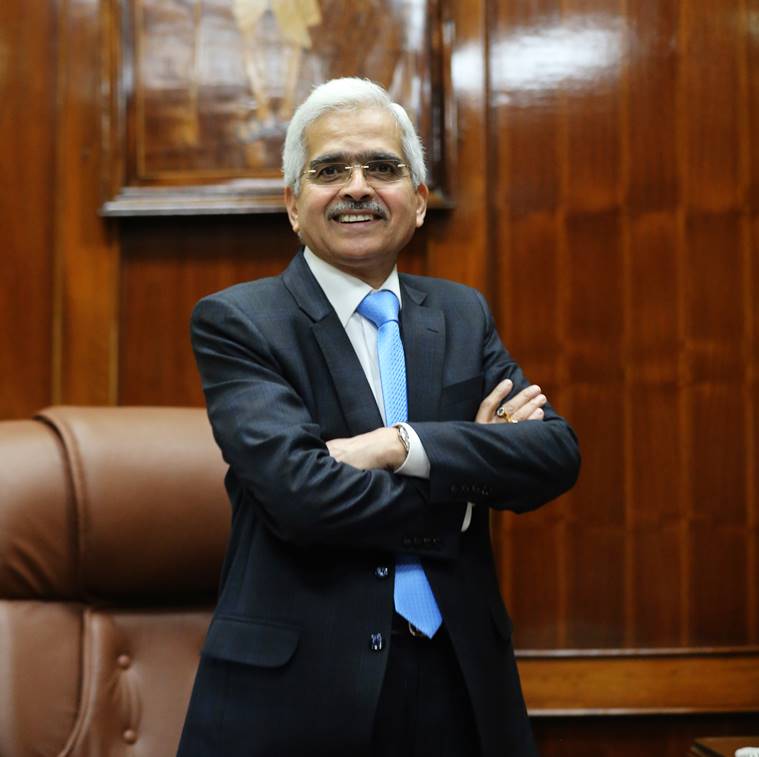 Das said” “If opinions differ… better I address government directly, internally.” (Express Photo by Tashi Tobgyal)
Das said” “If opinions differ… better I address government directly, internally.” (Express Photo by Tashi Tobgyal)
RBI has an empowered board today. How do you see the board contributing to RBI decision-making?
All the board members are fully in sync with the RBI’s institutional view. We have had very productive and very healthy discussions in the RBI Central Board and the Board members have been very appreciative of the RBI’s viewpoint on many issues. Of course, they give very important and very useful suggestions and at the RBI, we are always open to suggestions. I mean, I have been interacting with stakeholders. I regularly meet the public sector and private sector bank MDs and CEOs. I meet the rating agencies. I have met the various industry and trade associations, agriculturists, independent experts, economists, journalists, etc. Any suggestion is always welcome. Consultative approach always helps in understanding of issues and improving the quality of decision-making.
Some see RBI as having been more accommodative of the government’s concerns on a number of issues such as dividend transfer, regulatory forbearance, the one-day default rule… a number of issues where earlier governors had put their foot down. Is there a change in outlook?
When the government has any concern on any issue which impacts the economy, as the central bank, we have to consider those issues. Similarly, there are issues which, from time to time, are raised by the RBI with the government for its consideration. In the last one year, at least, there are several legislative and non-legislative proposals in the July 2019 and February 2020 budgets where issues concerning the RBI have been addressed; for example, the RBI Act was amended to give additional powers to RBI with regard to regulation of NBFCs and housing finance companies (HFCs) were brought under the purview of RBI. In the February 2020 Budget, the government has announced the amendment to the Banking Regulation Act, to give more powers to RBI with regard to regulation of the urban cooperative banks (UCBs). So, when both the government and RBI are trying to deal with issues related to the economy, there is need for exchange of views and ideas.
What is critical in this process is that we have to listen to each other, we have to appreciate each other’s views but eventually the decision is made independently. So, as long as decision is taken after engaging with the government, I think beyond that there is no need for any discussion on autonomy.
So you have that space for independence and autonomy?
Yes, absolutely. All decisions, which we have taken in the last year are our own objective, independent decisions.
On regulatory forbearance in specific sectors like SMEs and real estate, some observers point out that the RBI is only kicking the can down the road. Recognising bad quality assets is critical. You started the Asset Quality Review mechanism in 2016, and now you’re going back on that… giving sectors more and more time.
The first thing I would like to say is that it is not an across the board forbearance which has been given, rather it is specific and targeted, and subject to certain guidelines and parameters. Now, with regard to the real estate sector, you just mentioned about the relaxation granted in terms of permitting extension of DCCO (the date of commencement of commercial operations). In non-infrastructure projects, it is two years, whereas in infrastructure projects, it is three years. For various reasons, it was kept as one year for the real estate sector. So, when we made it two years, we aligned it with what is there for non-infrastructure sector. We have not really gone out of the way. And today, if you see the overall deceleration in growth, one of the main sectors impacted is real estate. There are various reasons for that. All that we have said is where there are reasons beyond the promoter’s control, we have considered that factor, and it’s not as if we have gone beyond a certain framework.
We have taken a very carefully designed calibrated call to deal with MSMEs — the largest employment provider and a critical part of our economy. When there is a slowdown, the impact is felt more by MSMEs. Large corporates, because of their financial muscle and the nature of their business, are probably able to deal with the situation in a better way. But then, it is difficult for MSMEs to come out of stress in a short period. We have tried to give them a calibrated restructuring option. It is not mandatory for banks to restructure all MSME loans. The banks have to assess the viability of units at the time of restructuring. Let me also say with emphasis that while deciding on all these measures, the aspect of financial stability and the stability of the banking sector is always uppermost in our mind.
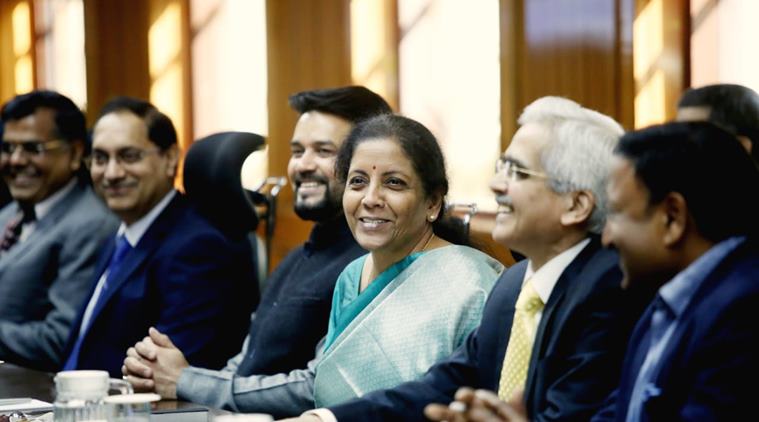 Union Finance Minister Nirmala Sitharaman with RBI Governor Shaktikanta Das during the RBI Central Board meeting at the RBI headquarters in New Delhi on February 15, 2020. (Express Photo by Praveen Khanna)
Union Finance Minister Nirmala Sitharaman with RBI Governor Shaktikanta Das during the RBI Central Board meeting at the RBI headquarters in New Delhi on February 15, 2020. (Express Photo by Praveen Khanna)
What is the quantum of loans being addressed in real estate and MSMEs?
In the MSME loan restructuring scheme announced last January, out of about 15 lakh eligible units, around five lakh accounts were restructured. The condition was that the loan should be standard as on January 1, 2019. We have widened the ambit but said, the loan to be eligible for restructuring has to be a standard asset as on January 1, 2020. Many more units may avail of the scheme.
In real estate, a large number of units will benefit from the permission to extend DCCO arising out of situations beyond the control of promoters. Such decisions are always preceded by a lot of internal consulting as well as consultation with financial institutions.
You mentioned the deceleration, but has the pace of the slowdown caught the RBI by surprise? There’s been a sharp revision by 2.4 percentage points over a span of 10 months or five policies. That seems unprecedented.
During the current financial year, deceleration came as a surprise to almost everybody. Definitely, there has been a steep decline. Having said that, we are not so surprised as most others. Right from the February 2019 monetary policy, when we started cutting rates, the market was surprised. We started cutting rates from February 2019 because the slowdown in the growth momentum was very clearly visible from the incoming data. And we do nowcasting internally. So RBI decided to act proactively and cut rates five times after February. By the third cut, all analysts agreed that RBI had acted proactively. Many central banks also initially expressed surprise at our decision to cut rates as early as February 2019.
An issue that has bothered many over the last 2-3 years is that of economic data release and on credibility of data. How do you view this?
We always go by CSO data and there is no reason to doubt their credibility.
More than three years have passed since the MPC framework has been in place. Has inflation as the sole benchmark really worked?
I think MPC framework has worked well. But, we are reviewing it. The legal provision in the RBI Act says that price stability should be the prime objective keeping in mind the objective of growth. So, the prime target is price stability 4% +/- 2%. But keeping that as the prime target, the aspect of growth has to be taken into consideration. Internally, we have already started a review of the working of the monetary policy framework in the last three-and-half years. And going forward sometime in June 2020, we propose to hold a roundtable with various experts, economists, analysts and other thinkers. Once our review is over, then we will place the outcome of our review before stakeholders. Based on that, we will take it forward. If there is a requirement, we will also take it up with the government. On the whole, inflation has remained under control during the last three-and-half years but for the recent spike on account of spike in vegetable prices, of which onion was the major factor. Other vegetables too contributed to the higher inflation, and in the last print, prices of milk, fish and egg too were higher. Going forward, we do expect it to moderate. With this temporary spike in inflation, we have not shifted our attention from growth. We are still focussed on growth. Because of the spike in inflation, we have decided to take a pause.
You became the national face to explain demonetisation almost on a daily basis when in government. With the benefit of hindsight and the benefit of where you are right now, how has demonetisation played out?
I think demonetisation has had positive impact on the economy in terms of formalising the economy, checking the so-called parallel economy/unaccounted money. It is still playing out, I will just say that.
Has the RBI undertaken any study on the impact of demonetisation, what it did to sectors like MSME?
No.
Measures such as LTRO (long-term repo operation) and CRR (cash reserve ratio) exemption had the effect of reducing the policy rate indirectly. There are some who question doing so outside the MPC framework.
It is actually not in the domain of the MPC because the MPC is focussed on maintaining price stability, and price stability is by way of control of inflation and the key component of monetary policy is the repo rate. Other than that, there are several other instruments, monetary and regulatory which are available to RBI. CRR is a monetary instrument, our decision on real estate is regulatory. We are not ignoring the MPC. It plays its role.
Kotak Mahindra Bank took the RBI to court, and yet you agreed to its offer to settle it out of court.
I don’t want to discuss individual cases. In this case, Kotak Mahindra Bank came to us with a certain proposal which we found broadly acceptable. And the matter now stands resolved.
There is still considerable concern in the market about some banks and NBFCs. Are you looking to resolve these?
So far as the NBFCs are concerned, the RBI closely and intensively monitors the top 50, which account for roughly 75% of the total portfolio. We have a clear understanding of what is happening. We are engaged with their management and promoters, trying to find market-based solutions. The sense we have is that there is a steady improvement in the NBFC sector over the last seven-eight months. Confidence levels have also improved. Even today as we discuss, there are a good number of NBFCs which are able to access funds from the market at competitive rates. With regard to banks, we monitor all the banks, both public and private sector, very closely. Our endeavour will be to ensure that no large systemically important NBFC collapses. We are very mindful of the aspect of financial stability in the case of banks too. RBI will always ensure that stability of the banking sector is maintained.
Also read | Foodgrains at all-time high, pressure on procurement
We had the Government listing green shoots…what would your definition of green shoots be?
There are many positive trends visible; PMI numbers, for example, in services and manufacturing but we have to see whether they are sustained. FDI numbers are better, lending to the commercial sector has also improved. In the last six months, the overall fund flow has improved. Of course, I have to qualify by saying that compared to last year’s corresponding period, it is lower, but still it is picking up, but we have to see whether it is sustained.
What is the status on two issues on which the RBI had concerns: sovereign bonds and RBI executives on boards of public sector banks?
RBI view has been that RBI nominee should not be there. There is a kind of a conflict of interest. On sovereign bond, as a debt manager of the government, we have conveyed our issues internally to the government.
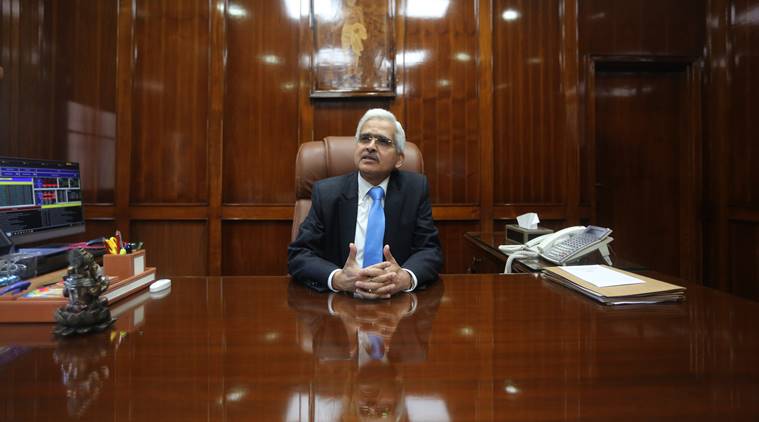 Das said the RBI is closely and intensively monitors the top 50 NBFCs. (Express Photo by Tashi Tobgyal)
Das said the RBI is closely and intensively monitors the top 50 NBFCs. (Express Photo by Tashi Tobgyal)
You use the word, “internally,” quite a few times. There’s a debate about how institutions should tackle issues with a government which is as strong as the government of the day. It is important to settle these internally?
Direct communication is always better. If I have a difference of opinion with the government, it’s better that I address the government directly and internally rather than voicing it through a third source, because then the confidence levels go down, either way. The real focus should be on the outcome, not anything else.
In the last year or so, India has added almost $65-70 billion to its forex reserves. Certainly, there is a cost to it?
The underlying theme of our forex management is to see that there is no undue volatility in the value of the rupee. Because an undue volatility would affect exports, imports and make life difficult even for manufacturers. So as long as currency is stable, then people can assess and estimate the value, and can take better quality decisions. Our effort is always to prevent any undue volatility and that stance has remained.
After you announced the LTRO, many asked why did the RBI not do it before for better rate transmission?
RBI is required to respond proactively because the situation is very dynamic today. We need to be proactively responding to the evolving challenges and issues. So, therefore, to infuse liquidity, we started a very innovative method for the first time, the rupee-dollar swap. Because, OMO had already been done to a large extent. Now, we did what everyone outside calls Operation Twist. We undertook simultaneous buying/ selling of securities — we were buying securities at the long end, but selling at the short end. Also, we undertook CRR-related measures and the LTRO. All the decisions we took are in response to the evolving dynamic situation.
Apr 18: Latest News
- 01
- 02
- 03
- 04
- 05















